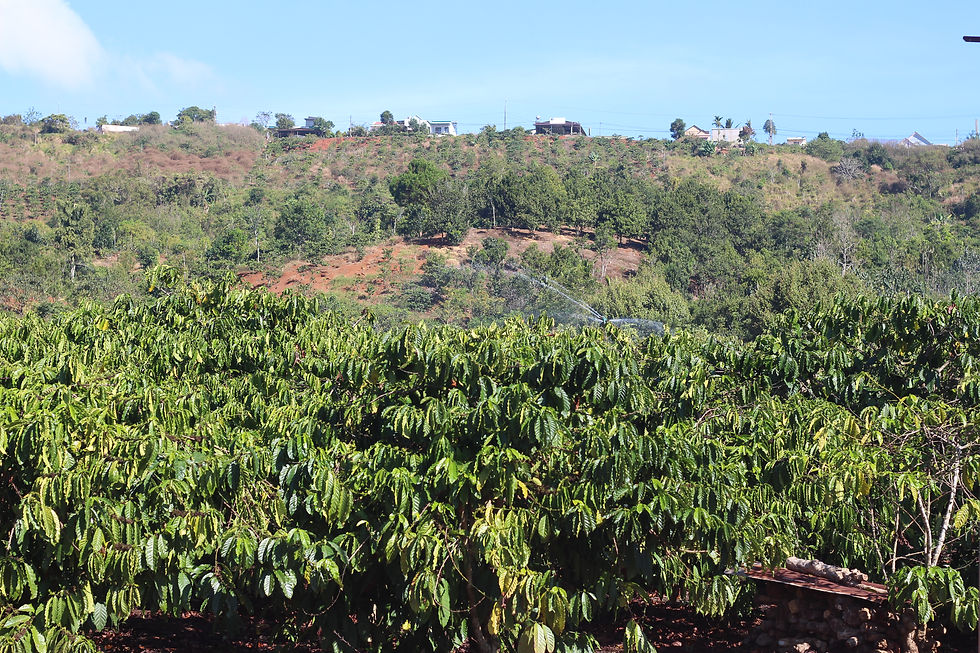EXPLORING THE CONNECTION BETWEEN CANEPHORA & ROBUSTA
- Duyen Nguyen My
- Apr 13, 2023
- 4 min read
Robusta coffee is generally considered of lower quality within the coffee industry. This perception stems from the belief that its beans result in an inferior cup of coffee with a less appealing flavor profile.
However, robusta has several advantages for farmers as it is less expensive to cultivate, more productive, naturally higher in caffeine, and resistant to drought and disease. Therefore, it is often used as a "filler" coffee, commonly blended with other varieties and used in instant coffee.
While it is partially true, there exist several misunderstandings regarding robusta coffee. Among them, the significant one is that robusta is not a distinct coffee species but rather a frequently used commercial name for the Coffea canephora plant.
This article explores what canephora is, and envisions the future of canephora.

Caphenora cherries - Vietnam
WHAT IS CANEPHORA COFFEE?
Canephora, which is also known as robusta, makes up about 35% of global coffee production, as reported by the International Coffee Organization (ICO). Although it was not cultivated outside of Africa until the 19th century, almost 300 years after arabica plants left the continent, it is now produced in various countries worldwide, including Vietnam, Brazil, Mexico, the Ivory Coast, Indonesia, India, and Uganda (Vietnam is the world’s largest canephora producer, followed by Brazil.)
Compared to arabica plants, canephora is generally more resilient, has a higher crop yield, and its cherries ripen more uniformly. It also naturally contains more caffeine and can be grown at lower altitudes, as low as 100 m.a.s.l., in tropical climates. The primary buyers of canephora/robusta are major roasters and manufacturers, who use it in capsules, blends, energy drinks, and other caffeinated products.
The demand for robusta is increasing, with robusta exports increasing while arabica exports decreased in the 12 months leading up to May 2020, according to the ICO. Despite its reputation as an inferior coffee, canephora is proving to be an important player in the global coffee market.

AN INCREASE IN QUALITY?
Canephora coffee is often blended with arabica coffee to enhance its strength and caffeine content. According to Aymbiré, incorporating high-quality canephora into the blend has several benefits, including increased body and crema capacity, which are typical features of a canephora cup.
According to him, the traits of certain species or varieties no longer dictate consumer choices in the coffee industry. Rather, individuals select coffee based on their own taste and preferences.

The coffee industry is experiencing a rise in high-quality robusta coffee. Quality standards have improved significantly in the past few decades, not only for robusta but for all coffee species. Aymbiré notes that advancements in crop management, harvesting, and processing have contributed to this development. Nowadays, even the most careless canephora producers are required to wash, peel, and pulp their coffee to meet the minimum quality standards.
However, the pursuit of quality comes with its own set of challenges. For instance, harvesting high-quality canephora often requires manual labor. Using machines for harvesting can damage the cherries, and since many canephora plants have multiple stems, it isn't always the most efficient option.
THE GROWTH OF SPECIALTY CANEPHORA COFFEE
When given the same level of attention as specialty arabica, some producers have discovered that robustas can produce a robust and flavorful cup. These coffees can have high acidity, medium sweetness, and low bitterness. With careful cultivation and roasting, canephora can result in a full-bodied coffee with a prolonged aftertaste, low-medium acidity, and bitterness. Some even describe the coffee as having hints of spices, flowers, and fruits such as melon, walnut, nutmeg, and cacao.
The processing, drying, and fermentation of canephora can follow the same methods as arabica, but the timing of each step will differ due to the unique characteristics of the fruit. Additionally, canephora requires different roasting techniques, as the cherries have lower sugar content, fewer acids, and a denser, more substantial structure.

The official Q Robusta program, launched by the Coffee Quality Institute in 2010, focuses on grading quality robusta using a methodology adapted from the Specialty Coffee Association's arabica program. Since 2018, Brazil's Specialty Coffee Association has accepted canephora producers as members and hosts an annual Canephora Cup of Excellence award.
Producers in the Amazon area of Rondônia, Brazil, are set to receive the world's first geographical indication (GI) for specialty robustas, officially recognizing the unique qualities of coffee from this origin. High-quality canephoras are also produced in other countries, including Ghana, Ecuador, the Philippines, India, and Thailand.
THE FUTURE OF CANEPHORA
Research programs and studies by World Coffee Research and the ICO are aiming to change the common perception that canephora coffees are of lower quality. Their goal is to determine the potential for quality in canephora, which is a naturally stronger plant that may fare better than arabica in the face of climate change.
Recent trials by Embrapa indicate that certain canephora cultivars may thrive at different altitudes and climates, expanding the areas in which it can be grown. This genetic adaptation of canephora material could be viable at altitudes ranging from 500 to around 1,500 m.a.s.l. and could create sweeter and bigger cherries in colder climates. Similar programs conducted in India have also yielded positive results.
Additionally, the high caffeine content of canephora varieties makes them appealing for use in cosmetics, diet supplements, isotonics, and energy drinks, which could increase demand for the crop beyond the coffee industry.

All of these factors create a more favorable foundation for Canephora/Robusta plants to regain their position and rightful place in the coffee industry as a whole and in the hearts of consumers in particular.
References: https://perfectdailygrind.com/2020/08/exploring-the-connection-between-canephora-robusta/




Hello, thank you for reposting my article. Could you please quote my name as author, please? Isabelle Mani SanMax, and add my Linkedin page https://www.linkedin.com/in/isabelle-mani/ Thank you so much!